Archived Commercial Blog Posts
SERVPRO Is Faster to Any Size Disaster
9/13/2023 (Permalink)
 We arrive Faster to Any Size Disaster.
We arrive Faster to Any Size Disaster.
When disaster strikes you need a restoration team that can begin work immediately. SERVPRO can serve more than 90% of the zip codes in the United States in under two hours, making us faster to any size disaster.
SERVPRO Helps Close Your Insurance Claim Fast
There are several ways SERVPRO helps insurance professionals complete claims fast:
- Locations Near Most Customers
We have over 1,900 locations in the United States and Canada. No matter where your customers in Pueblo, CO, are located, chances are we can get a restoration professional to them in under two hours.
- Always Available
An emergency can happen at any time, so you need a restoration company that is always ready to respond. SERVPRO professionals are available 24/7 to provide immediate assistance.
- Highly Trained Professionals
We have more than 50 years of experience in the restoration industry and all of our professionals are highly trained. Our Institute of Inspection, Cleaning and Restoration Certification-approved training facility provides training for new professionals and franchisees, continuing education and training for insurance professionals.
- One Stop Shop
Most disasters cause more than one kind of damage. Our team is trained to perform restoration for water, fire and storm damage. We can also find and remove mold and provide tarp and board-up service. SERVPRO provides specialty cleaning, air duct/HVAC cleaning and biohazard and crime scene cleaning. Additionally, we can restore documents, remove odors, vandalism and graffiti and clean carpets and upholstery.
- Competitive Advantage
Our quick and effective services help insurance companies also be faster to any size disaster. When you use SERVPRO, you will enjoy lower claims costs, increased customer satisfaction and lower loss ratios. This gives you an advantage over your competition and helps you retain customers.
- Customer Focus
Our goal is to restore your customers to preloss condition as quickly as possible. Happy customers mean fewer headaches for insurance companies.
- Lower Costs
We know that restoring property costs less money than replacing it. We work hard to ensure that all property that can be restored is restored.
- Trusted Vendors
We work with vendors on your behalf so that you don't have to. We only work with the best vendors in the industry so you never have to worry about subpar work.
- Guaranteed Quality
All of our work is backed by a two-year labor and one-year materials warranty. If our work fails to meet your reasonable expectations, we will do it again at no additional cost for up to two years.
- Dedicated Insurance Team
We have a dedicated team whose only focus is keeping our insurance customers happy. We keep the lines of communication open so that any time you have a concern, we are always available to address it.
- Industry-Leading Standards
We make sure our high standards are always met by conducting internal audits. Only franchisees who meet our more than 21 requirements get insurance referrals. SERVPRO takes meeting the needs of insurance clients and their customers seriously.
No matter how large or small the job, we are prepared to demonstrate why we are faster to any size disaster.
Common Problems That Require Commercial Water Repair
7/31/2022 (Permalink)
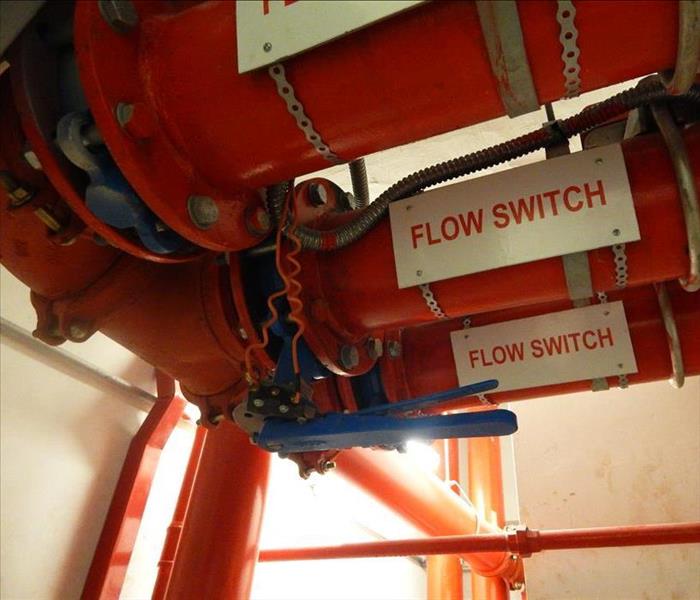 A broken pipe can cause severe water damage.
A broken pipe can cause severe water damage.
Commercial properties share some of the same water damage risks, such as a broken pipe, as residential properties. However, commercial properties also have unique risks because of the size, scale and nature of their operations. These are some of the most common water damage issues in commercial buildings.
Common Commercial Water Repair Issues
Commercial property owners face several common issues that can lead to water damage:
1. Clogged Drains
Because of the large volume of waste passing through drains, commercial properties frequently have issues with clogged drains. Additionally, employees and members of the public may not take the same care when using commercial plumbing systems, leading to additional problems due to objects and substances being flushed down toilets and dumped into sinks that shouldn't be. Clogs may lead to flooding from sink and toilet overflows that require cleanup by a water restoration service in Pueblo, CO.
2. Water Temperature Issues
Commercial water heaters are large and complicated. This makes them prone to deterioration which can lead to issues with water temperatures. Depending on the severity of the problem and the nature of the operations, this could cause minor inconveniences, such as a lack of warm water in the bathroom sink, or major problems, such as water not being kept at the required temperature for industrial processes or regulations.
3. Pipe Damage
Many commercial buildings contain hundreds of miles of pipes that carry thousands of gallons of water. A broken pipe can cause significant property damage and service disruption.
4. Leaks
The sheer number of pipes and fixtures in many commercial buildings can make it difficult to avoid leaks, particularly if regular maintenance schedules are not followed. In addition to sinks and toilets, industrial equipment and sprinkler systems may require pipes and supply lines that cause leaks. Damaged roofs and leaky foundations can also be a source of water issues.
5. Sewage Smells
Dry pipes, clogs and other issues can cause sewage smells to permeate a commercial building. When this happens, businesses may lose customers or be forced to shut down while the source of the problem is investigated and resolved.
6. HVAC Problems
HVAC units can cause water damage due to frozen evaporator coils, clogged drains and improperly connected pipes. Many HVAC problems can be avoided with regular maintenance and inspection.
7. Vacant Buildings
Vacant buildings do not use water in the same way that occupied buildings do; however, when a problem occurs it may not be detected for a long time. Water sources to vacant buildings should be shut off and buildings should be regularly inspected for leaks.
8. Boiler and Machinery Malfunctions
Boilers and other commercial equipment that use water can malfunction leading to leaks, burst pipes and other types of water damage. This equipment must be properly inspected and maintained to avoid problems.
9. Sewage Backup
Sewage backups can be caused by clogs and heavy rainfall. While this type of damage is not as common as other types, it can be particularly severe because of the need to clean and sanitize the impacted areas.
A broken pipe can happen in any type of building. However, commercial buildings face unique challenges that require vigilance from building owners.
First Aid Tips for Burns in the Workplace
7/26/2022 (Permalink)
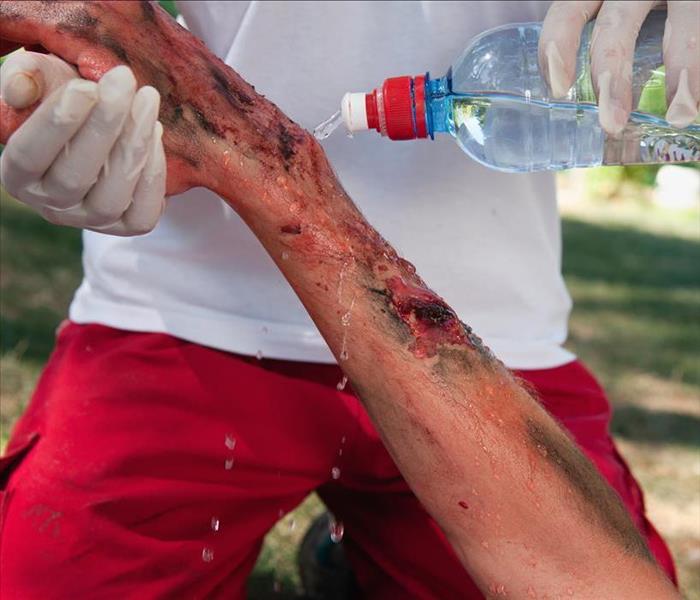 Learn first aid for burns.
Learn first aid for burns.
If a fire occurs in your Pueblo, CO, commercial building, your first concern should be the safety of your employees. Before you assess any fire damage, you should see if any of your workers need first aid.
Burn First Aid Tips for the Workplace
Burns are a common cause of injury during a fire. If an employee suffers a burn, you must determine how severe it is. A major burn requires emergency medical intervention. A major burn:
- Swells quickly
- Is at least 3 inches or 8 centimeters in diameter
- Encircles a leg or arm, or covers the groin, buttocks, feet, face, hands or a major joint
- Appears charred, or has brown, black or white patches
- Goes deep into all layers of the skin
- Makes skin leathery and dry
Treating Major Burns
If you suspect that an employee has a major burn, call 911 immediately. While you wait for first responders to arrive, you should raise and cover the burn. If possible, lift the wounded area so it is above the victim’s heart. Then put a clean cloth or gauze on top of the burn.
Since burns often lead to swelling, you should remove any tight belts or jewelry that the victim is wearing. Necklaces, in particular, could choke the victim if the neck starts to swell.
You should also keep a close eye on the victim to ensure he is still breathing. If you do not see or hear his lungs inflating, perform CPR immediately. Burn victims can quickly go into shock, as well. Signs of this condition include shallow breathing, clammy skin and a weak pulse.
Finally, keep the victim away from further harm. If possible, remove him from the source of the fire. Do not take off any clothes he is wearing, as doing so could make the damage worse.
Treating Minor Burns
An employee could also suffer a minor burn whenever fire damage occurs to your property. You should be able to treat this burn with basic first aid. Start by putting the burn under cool running water for approximately 10 minutes. If the burn is on the victim’s face, use a wet, cool cloth to ease the pain.
If blisters start to develop, do not pop them. They help prevent infection. If a blister does burst, apply water and an antibiotic ointment to the wound.
After the burn has cooled, rub a lotion onto the injury. Ideally, the lotion should contain cocoa butter or aloe vera. The lotion relieves pain and hydrates the skin.
Finally, place a clean bandage on top of the burn. Be sure to wrap it loosely so it does not put too much pressure on the burned skin. The victim can also take over-the-counter pain medication if necessary.
Once you have treated all employee injuries, you can move on to the next step of the recovery process: restoring your property. Fire damage cleanup professionals can remove charred items from your building and reconstruct any destroyed walls or roofs.
Immediately after a blaze, you may have to administer burn first aid to one or more employees. By following the above steps, you can limit how much harm the burns cause.
Smoke Cleanup Methods
5/12/2022 (Permalink)
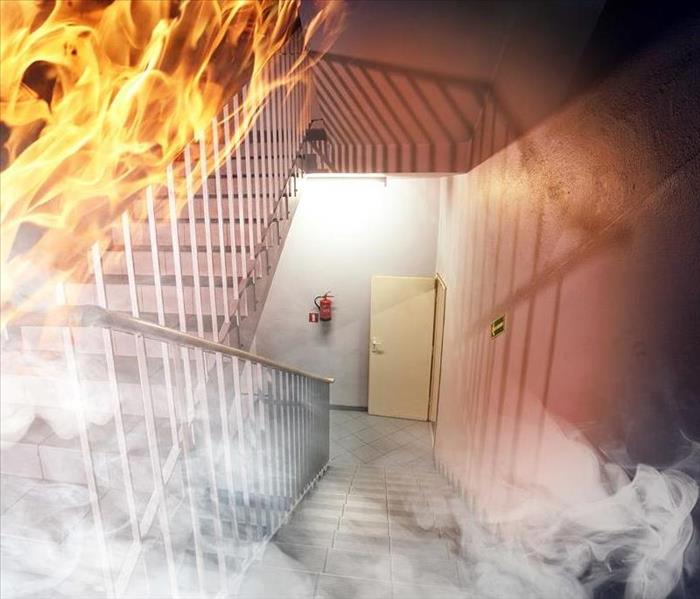 Our Professionals have Smoke Cleanup Methods that can Help you Avoid Further Damage.
Our Professionals have Smoke Cleanup Methods that can Help you Avoid Further Damage.
Anything that flames touch when your building in Pueblo, CO, catches fire can cause immense structural damage. That's not the only thing that happens, though. Smoke can infiltrate not only the area where the fire is actually located but also any space where the air around it can reach. It can even go so far as the building next door!
There are several ways that fire damage restoration experts can incorporate smoke cleaning during remediation.
Ways to proceed as regards Smoke Cleanup
Ozone Treatment
One method of getting rid of smoke and its telltale smell is through an ozone treatment. Technicians use a machine that creates ozone molecules much like the ones generated during a thunderstorm to naturally clean the air. They attach to smoke particles and destroy them. The treatment process is fairly straightforward:
- Seal off the space receiving treatment.
- Plug in the ozone machine and turn it on.
- Allow the machine to run for 3-6 hours.
- Let the room air out as the ozone settles.
It is not advisable to use ozone around people. The gas it creates is unstable, so the space will need to be vacated before the smoke damage treatment begins. However, in a relatively short amount of time, the odor will dissipate. Then the mitigation team can move back in to test and confirm that the treatment was successful.
Smoke Odor Filtration
Sometimes the only smoke cleaning a room needs is air purification. This is especially true in spaces adjacent to where the fire actually took place. Technicians use an industrial air filtration device with HEPA filters that process the air in the space and remove particles directly from it as it flows through the machine. Because it doesn't create any new molecules or chemicals, it is acceptable to use even in spaces that are populated.
Thermal Fogging
No matter how well technicians sanitize each surface, stubborn smoke odor can still linger. Smoke can travel anywhere the air goes, which means it gets into every crack and crevice that it can. This is particularly true while the fire rages and high temperatures make it easier for particles to permeate everything in their path.
A thermal fogger essentially recreates the conditions that are present during the fire. Instead of smoke, though, it spreads a deodorizer to all the areas where the damage reaches. No matter how small the cracks are in the space, the fog does a thorough job of soaking in. The cleansing chemicals neutralize the smoke and thus the smell that results from it. After the space is aired out, the odor is gone.
You can completely remove damaged structural elements and rebuild the ruined parts of your building after a fire, but if the mitigation team doesn't also take the time to get rid of the smoke issues, the odor is likely to linger. After assessing the problem, qualified technicians can choose the method that is best for getting rid of it. Smoke cleaning allows your building to smell as fresh as it looks at the end of the restoration process.
The Most Important Steps After a Partial Fire Loss
4/13/2022 (Permalink)
 Partial Fire Loss have many important Steps to Follow.
Partial Fire Loss have many important Steps to Follow.
The common image of a large business fire is one that burns down the entire structure, leaving only a few smoldering ashes and a vacant lot. Most fires, though, do not result in a total loss of property, but instead only impact part of the company. This fire loss could also involve such things as smoke and soot damage, as well as damage from fire suppression techniques.
When dealing with a partial loss fire, the company must deal with two important elements. The first is the cleanup from a qualified fire restoration service in Pueblo, CO. This business will work through the damage in an orderly fashion and seek to repair, replace and restore damaged items. In some cases, a restoration of an item will be more cost-effective, while other scenarios will call for a replacement of a damaged item.
The goal is always to restore the business as quickly and efficiently as possible. There is also a concern for the overall cost of the cleanup and restoration process.
A Partial Fire Loss and Insurance
The second critical element of a commercial fire involves working with the insurance company. This is often done in coordination with the cleanup service. In the best of worlds, the cleanup company will provide accurate documentation of such things as smoke damage to the insurance provider, and this will make the claims process run more smoothly.
Part of the process involves a thorough inspection of the damage. Depending upon the scope of the fire, this could mean looking at everything from structural and electrical damage to harm to furniture, lighting, computer equipment and documents. Companies should watch out for their own interests and make sure insurance adjusters do not miss any of the following damages:
- Hidden damage that is not automatically obvious
- Cleanup procedures that do not follow industry standards
- Repairs that do not match the quality of the original construction
The fire restoration and the insurance process should be orderly and professional, but each situation after a fire is different. If the fire is part of a larger disaster, it might be difficult for a company to find the necessary personnel to do the work. The company could also be demoted to a lower priority as emergency crews become busy with other projects, including the saving of life and limb.
Restoration and Insurance
At some point, the cleanup will focus on damaged items that can be restored to good shape again. This saves both the insurance company and the business time and money. A professional fire cleanup company has many tools at its disposal to restore items. This includes cleaning soot from walls, ceiling and flooring, as well as removing it from personal items.
The process also involves cleaning and sanitizing with a variety of techniques embraced by industry leaders. Industrial air scrubbers and fogging equipment can remove odors that cling to some items. In most cases, the insurance company should pay for these services.
A partial fire loss has many moving parts and can be a challenge for a company. Things tend to run more smoothly when the cleanup company and insurance work together after a fire.
Engineering and Flood Prevention in Cities
3/12/2022 (Permalink)
 Engineering plays a key role in Flood Prevention. Learn more by following These Tips.
Engineering plays a key role in Flood Prevention. Learn more by following These Tips.
Have you ever wondered about the role of engineering in flood prevention in cities and municipalities? In places like Pueblo, CO that experience frequent high water and flooding, building structure and architecture play a huge role in preventing catastrophic damages.
In fact, many communities across the country develop plans to stop flooding and limit the damage and disruption flooding causes in an area.
Professionals who play a Key role in Flood Prevention.Agricultural engineers, civil engineers, environmental engineers, materials engineers, and mechanical engineers all play a vital role in flood prevention.
Agricultural Engineers
Agricultural engineers attempt to predict how water moves. These engineers utilize their predictions to determine the best location for retention ponds, wetland buffers, and greenways. Structures like retention ponds, wetland buffers, and greenways are permanent and created to hold water flow and control water. Agricultural engineers play a role in designing dams and structures that function similarly to dams.
Civil Engineers
Civil engineers provide city agencies and authorities with engineering analyses that help develop flood management plans. Civil engineers suggest infrastructural models for systems like drainage networks and flood gates.
These engineers conduct structures that contain and divert flood water. They develop structural designs that are utilized throughout cities and towns to prevent flooding.
Civil engineers also design transportation ways such as roads and train rails that can function in high water. They also design elevated bridges and buildings made to withstand flooding.
Ecological Engineers
Ecological engineers utilize the natural environment to prevent flooding. They combine ecology, or the relationship between humans and their natural environments, and engineering methods. When it comes to flooding, these engineers aim to prevent damage. They also implement models to design, construct, restore, and manage the environment.
For example, ecological engineers identify communities susceptible to riverine flooding. They may contribute to a city flood plan by combining green infrastructure practices with conserving land, possibly by identifying water-retention soils near the city.
Materials Engineers
Materials engineers study and develop materials at the atomic level and model the characteristics of the substances they research. To address flooding, materials engineers seek to lessen the severity of flooding and stop flooding. They design paving materials that are water-permeable and reduce water runoff, especially in cities.
Mechanical Engineers
Mechanical engineers work with electrical engineers to design generators and water pumps adaptable to high water. In areas that are at high risk for flooding, they may even put air conditioning units or heating units in elevated areas rather than at-risk places like basements.
In cities, mechanical engineers may develop technology designed to keep subways dry. In a subway system, mechanical engineers may use pumps that convert kinetic energy to hydrodynamic energy. This way, the pumps move flood fluids away from the subway.
Engineers and Flooding
Engineers provide other services that go into plans designed to stop flooding and flood damage. Chances are, engineers have played a vital role in protecting you and your city from flood damage. As a field, engineering considers flood engineering an area of expertise that requires certain skill sets and proper education. Some states even require flood control engineers to earn certifications and licensing before they can address floods.
How To Avoid Secondary Damage From Bursting Pipes
2/18/2022 (Permalink)
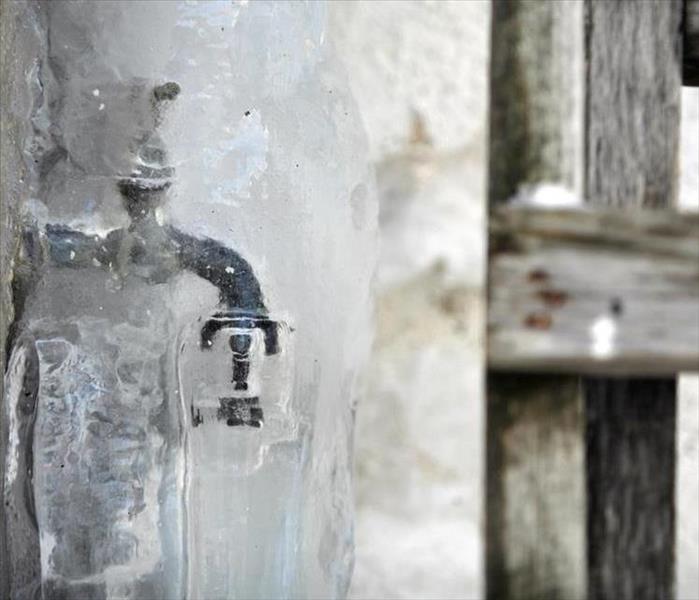 Follow these tips To Avoid Secondary Damage From Bursting Pipes in your Pueblo, CO Property.
Follow these tips To Avoid Secondary Damage From Bursting Pipes in your Pueblo, CO Property.
Bursting pipes can cause serious damage to the plumbing in your building, but direct damage to the plumbing isn't the only problem they can cause. Secondary damage can cause extensive problems throughout your building.
Avoiding Secondary Damage From Bursting Pipes
Water damage from the broken pipes is one of the first things you may notice after a pipe breaks. There are several steps you must take to mitigate the damage:
- Shut off the water supply
- Fix broken pipe
- Inspect the plumbing for additional broken or frozen pipes
- Remove water and dry out the building and contents
You can shut off the water by either turning your main shutoff valve to the off position or contacting your utility company in Pueblo, CO. You may be able to repair the section of broken pipe yourself, but if not, contact a plumber to make the repair before you turn the water back on. Contact a water remediation company to remove any standing water and help dry out your building and contents. The longer wet conditions persist in your building, the more likely you are to have secondary damage from the water.
Secondary Damage From Water
Water from a burst pipe can cause multiple types of secondary damage. It may cause wooden materials to warp or rot. It can cause metal to rust. The high humidity may promote mold growth. In winter, moisture in the air freezes when it contacts windows and exterior walls and doors. This can cause damage to joints and drywall. The best way to avoid these problems is to fix the source of the excess water and dry out the property as quickly as possible.
Avoiding Burst Pipes
The most effective way to avoid secondary damage from burst pipes is to avoid the primary damage. There are several steps you can take to reduce your risk:
1. Leave the Heat On
Many business owners turn the heat down during closing hours to save energy. When cold weather is in the forecast, don't turn the heat down. Keeping your building warmer reduces the risk of a pipe freezing.
2. Increase Circulation
Pipes are often located in areas where warm air from your heating system may not reach. Open doors and cabinets to make it easier for warm air to reach your pipes.
3. Insulate Your Building
Insulation in the walls of your building and around your pipes can help prevent freezing. Pay particular attention to pipes that are outdoors or near exterior walls.
4. Let the Faucet Drip
Opening faucets enough to allow a drip keeps water moving in your pipes, which lowers the risk of freezing. If your building is going to be unoccupied during cold weather, you may want to shut off the water and drain the pipes.
5. Fix Holes
Check the walls of your building for cracks and holes and repair any that you find. This will help keep cold air out of your building.
Primary damage from bursting pipes can be a major headache for property owners. However, secondary damage can sometimes be an even bigger problem. Taking steps to mitigate this damage can save you a significant amount of time and money.
Advice Pueblo Business Owners Can Use to Rebuild After a Disaster
2/16/2022 (Permalink)
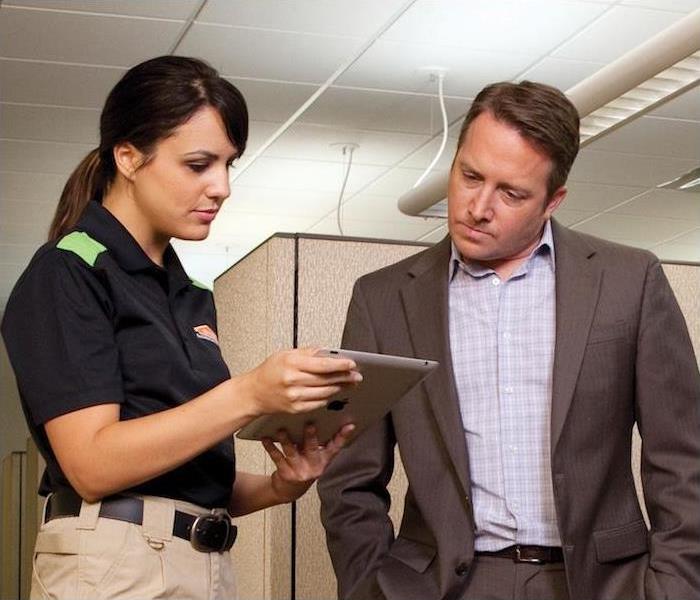 Keep your business running after a natural disaster following these steps.
Keep your business running after a natural disaster following these steps.
What was the most important lesson you’ve learned during the COVID-19 pandemic? A lot of business owners have a similar answer. It’s that you can’t plan for everything. Sometimes being smart and agile means looking for new ways to reach your customers and continue operating. And it’s impossible to predict what might happen in the future.
These are great lessons to learn, and they can move into other aspects of your business, including being prepared for more predictable natural disasters like severe storms, fires and floods. Many business owners already have disaster plans in place for these (even if they didn’t plan for a pandemic).
If you own a business in Pueblo, we’re here to support you during any time of disaster. We understand that planning for a disaster is one thing, but living through it and continuing to conduct business is something else entirely.
As a way to support you, we’ve pulled together some of the best tips we have to help you deal with moving forward after a storm, fire or flood.
Your Best Next Steps
You can reopen your business quickly and efficiently after a disaster. Here’s how we recommend that you do it:
Work your disaster plan. It’s smart to work on this plan before you need it because you’ll be in a better frame of mind to think things through. For example, some may consider moving to a backup location to continue offering services.
Work as closely as you can with your insurance company. Be ready to provide what your insurer will need to help you move forward. In most cases, that will be photos of the damage (before it’s cleaned up) or an inventory that details lost or damaged items if you can, including their value, too.
Keep your community in the loop. Don’t neglect your suppliers, your employees, your customers and your wider community. They’ll want to know how your business is progressing and any other ways they can support you. You can also share a temporary location using social media or an email list.
Choose reliable partners. Don’t work with any restoration company that doesn’t communicate regularly and uses advanced equipment designed to restore your business to its original state.
If a fire, flood or any other cause damages your business, you can always count on SERVPRO for restoration assistance. We have crews who are available 24⁄7 in the event of an emergency. Contact us at any time to learn more about our restoration services and how we can help you.
6 Common Commercial Water Damage Problems
1/14/2022 (Permalink)
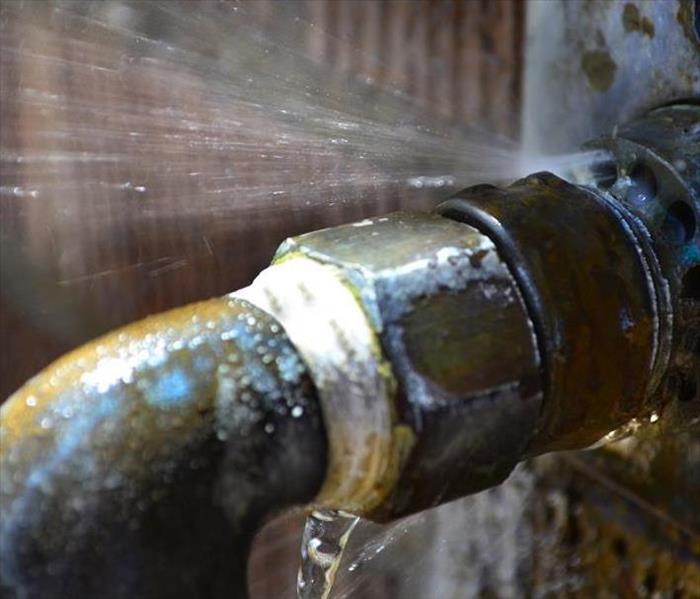 A broken pipe can lead to water damage in your Pueblo, CO commercial.
A broken pipe can lead to water damage in your Pueblo, CO commercial.
Water from a broken pipe or another source can disrupt operations and severely damage property. Quick action is critical to mitigating the amount of damage caused. Knowing the most common sources of commercial water damage can prepare you to act quickly if they occur on your property.
Common Reasons for Commercial Water Repair
Most commercial operations have some of the same water damage risks as residential structures, plus additional risks related to the operation of the business. These are some of the most common causes of flooding and other commercial water problems:
1. Leaking Sprinkler Systems
Sprinkler systems are a valuable resource for mitigating fire damage. However, damaged or poorly maintained sprinklers can lead to leaks that may damage your property. Watch for signs such as wet carpets and walls, mold, musty smells, and standing water. Have a professional in Pueblo, CO; inspect your sprinklers regularly and promptly repair any issues.
2. Damaged Windows
Damage to your windows or window seals can cause moisture to seep into your building. This excess moisture can cause mold growth, warp wood and lead to other types of water damage. Regularly inspect your windows and window seals for damage. Caulk damaged seals and repair or replace damaged windows as needed.
3. Plumbing Issues
A broken pipe can cause a substantial amount of damage if you are not quick about shutting off the water source. Freezing temperatures, wear and tear, and lack of maintenance can lead to pipe failures. Water stains on floors, walls, or ceilings, musty smells, and loose or cracked tiles can be signs of a leaky pipe. If you suspect a plumbing issue, contact a plumber to perform an inspection and repair any damage. Removing the water from your building is critical for reducing the damage, so consider contacting a water remediation company to dry out your property quickly.
4. Roof Damage
The roof on your building helps protect your property from wind, rain, and snow. However, a roof that has been damaged by a storm, heavy snow, ice accumulation, tree limbs, wind, or wear and tear may develop leaks. A leaking roof can lead to damage to ceilings and other structures in your building. Regular roof inspections, maintenance, and repairs can help you avoid damage from a leaking roof.
5. Damaged HVAC Systems
As your HVAC system ages, the ducts can become damaged or worn, leading to water leaks. Regular cleaning and maintenance reduce the chance of this occurring.
6. Severe Weather
The risk of weather damage to your property varies depending on where your property is located; however, most geographic regions experience severe weather at least occasionally. Hurricanes, flash floods, thunderstorms, heavy snow, earthquakes, and other events can either directly cause water damage or can create conditions, such as holes in your roof, that lead to water damage. You can't prevent bad weather from happening, but you can take steps to weatherproof your property.
Whether are you dealing with damage caused by a broken pipe, a flood, or poor maintenance, the key to reducing water damage is to act quickly. Regularly checking for signs of these common causes of commercial water damage can help you spot and fix problems early.
Does Your Business Need a Disaster Plan?
12/20/2021 (Permalink)
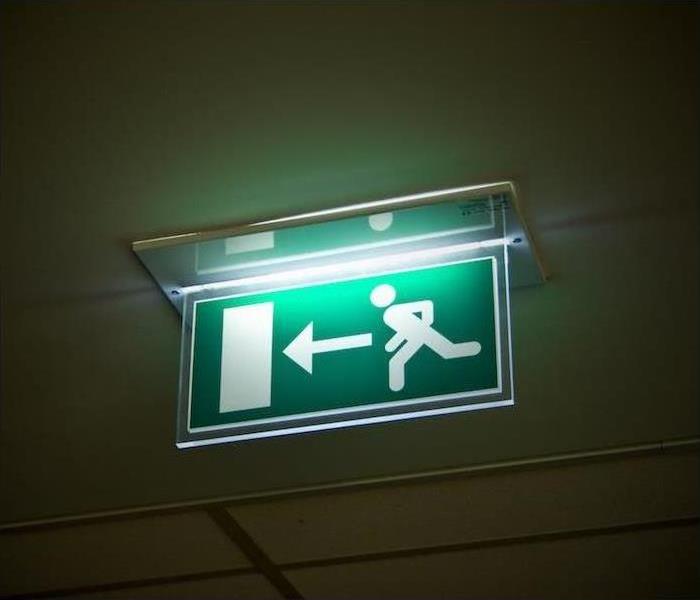 Keep everyone safe when a disaster occurs in Pueblo, Co.
Keep everyone safe when a disaster occurs in Pueblo, Co.
Have you noticed how Mother Nature keeps throwing natural disasters such as floods, hurricanes, tornadoes, wildfires, and earthquakes at our Pueblo, CO commercial? The key to being able to fight back is being prepared for a multitude of worst-case scenarios.
Being prepared for those scenarios in your home as well as your business involves creating a natural disaster plan. In this blog, we are going to discuss some aspects to consider when designing a disaster plan for your business.
Why Disaster Planning?
There are many things to factor in when you are putting together a disaster plan for your business.
Included in those considerations are the following:
- Keeping your employees protected
- Keeping your assets secure
- Getting your business back up and running again
Many sources such as the Red Cross, FEMA, and Ready.gov have prepared helpful checklists that can guide you in identifying areas that need to be included in your natural disaster preparedness plan. These sources are also useful in measuring just how prepared you truly are.
How to Protect Employees
Protecting the human aspect is the most important consideration if a disaster were to strike without warning. You must have a plan that lays out procedures and safety measures for employees and visitors by making sure evacuation routes and exits from your facility are all properly marked, ensuring that there is a designated area that can serve as a shelter space, possibly considering the installation of emergency lighting, and creating a volunteer staff to serve as “safety wardens” who are properly trained and able to guide and assist with all emergency efforts.
When you are picking out a shelter space, a basement or storm cellar is an ideal location in the event of tornadoes or other high-wind situations. If you have no basement space, you may use a small interior room, a closet, or an interior hallway on the lowest level of the building for shelter.
Asset Safety Is Key
There are thousands of dollars at risk in assets and merchandise even if your business is located in a strong and sturdy brick and mortar location. You will have to make mindful choices about how to protect the assets on the inside.
It is a good idea to compile a comprehensive and up-to-date inventory of these items, and having photographs prior to a disaster whenever possible is always helpful when filing insurance claims. When you have assets that are based on a computer server, take necessary steps to ensure that the regular backups are being performed and look into storage systems such as cloud storage options that cannot be damaged.
Contact a contractor to help you uncover areas that may need structural integrity upgrades if you own your building, and have the contractor walk you through possible safety upgrades and advise on any areas that may not hold up in certain weather situations.
How to Get Back to Work
After a natural disaster occurs, it is quite possible that damages will force you to close your business down while repairs are being made. Every day you remain closed is another day you lose money and profits. It is a good idea to have a “rainy day” fund set aside to help out with any additional costs that are not covered by your insurance.
Knowing what to do when disaster strikes your business is of the utmost importance. When it comes to the cleanup and restoration aspects, call SERVPRO of Pueblo and we will there for you.





 24/7 Emergency Service
24/7 Emergency Service









